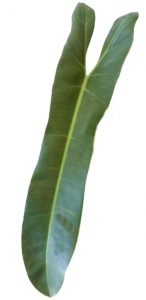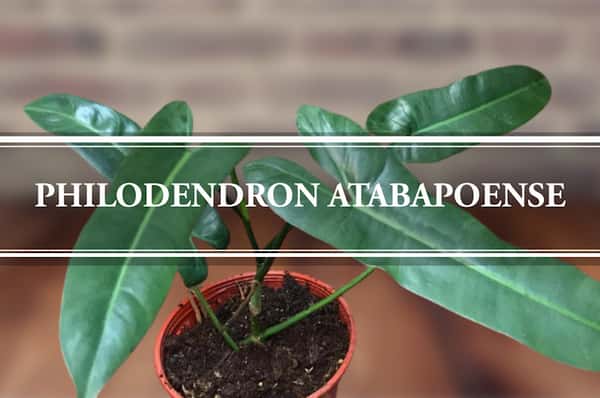Philodendrons secure their position in modern plantations for their appearance and resilience. We are going to discuss another one, the Philodendron atabapoense. It belongs to the Southern side of Venezuela and the Amazonian side of Brazil.
Moreover, G.S. Bunting was the first to classify this rare peep back in 1975. With the capacity of getting gigantically tall in wild, this semi-epiphytic plant can get about 2 meters long indoors.
The elongated heart-shaped leaves are dark green and glossy with reddish undersides. To your surprise, mature leaves can get about 30 inches long with a narrow width of 3 to 5 inches only.
Want to know more? This is a pretty easy and low-maintenance choice to create an artistic touch around you. Keep reading to enjoy a summarized guide about the care and propagation of the Atabapoense Plant.
Philodendron Atabapoense Classification
Family: Araceae.
Genus: Philodendron.
Species: P. atabapoense
Genus Philodendron
A vast and one of the most popular genera comprising of about 500 plant species. C.Plumier first introduced it back in the 16th century. Howbeit, they had been a part of ancient folk and medicine for ages.
All these flowering plants natively belong to the central and southern rainforests of America. As far as growth habit is concerned the diverse genus includes both climbing and non-climbing species. Experts have extensively involved these plants in hybridization and cultivation to make a range of new plants.
Features of the Philodendron Atabapoense Plant

Size:
- The size of the plant is dependent upon several features including space and the atmosphere. You will be surprised to know that these plants may exceed 20 feet in the wild. Howbeit, your indoor growths will remain around 2 meters at max.
Leaves:
- The shiny and elongated heart-shaped leaves may get about 2.5 feet long on maturity. The long and sleek look is what gives the unique look to the plant.
Philodendron Atabapoense Flower:
- Typical Aroid flowers grow on the spadix under the cover of the leaf-like spathe. This inflorescence looks like a large flower. However, this is just a modified leaf while the tiny flowers growing on the spadix are the real ones.
- Indoor peeps rarely flower. Still, you can expect a thin long stalk with the spathe in the warm days of spring and summer.
Toxicity:
This plant too carries the toxic legacy of the family. Higher levels of Calcium oxalate crystals make the sap toxic for us and animals. Close contact may lead to skin allergy and rash. Also, ingestion can lead to inflammation on the lips, mouth, and oesophagus.
Philodendron Billitae x Atabapoense
This is a rare Aroid cultivar coming from the cross of P. billitae and the P. atabapoense. The plant shows a close resemblance with both of the parents, getting the orangish petioles from Billitae and the elongated green leaves from the other one.
All the features like maintenance and propagation of this cultivar are pretty the same as that of the Philodendron atabapoense. So, keep reading further to learn more.
Philodendron Atabapoense Care
These low-maintenance and resilient Aroids can easily bear minor neglect. All the beginners and busy folks can get these without thinking twice.
Quick Guide:
Water: Average (Water right after the upper soil gets slightly dry)
Sunlight: The medium indirect sun.
Humidity: Preference for higher and tolerance for lower levels.
Fertilizer: Mild monthly doses on warm days.
Want to know more? Keep reading further to understand in detail;
Water Requirements
These tropical natives like to stay in moist soil. Water it thoroughly and let the upper layer of soil get slightly dry before watering again.
We always recommend understanding the drying patterns of the soil in your zone. This will help you to create and maintain a watering routine that changes for every season. In the warm days of spring and summer, the plant grows actively needing more water. About twice to thrice a week is usually enough.
On the other hand, the plant gets dormant in cold and reserves its resources of energy. Thus, once every two weeks is a good estimate for an average climate.
Just like all Philodendrons, over-watering can cause root-rot and is quite dangerous.
Sunlight Requirements
Indirect sun in medium intensity is ideal for the philodendron atabapoense plant. Avoid direct exposure, as the delicate leaves can not tolerate the intense sun.
Temperature Requirements
The ideal temperature range for the majority of the Philodendrons is 65 to 85°F. Keep the low cold tolerance of these plants in mind. Don’t forget to keep them at a warm spot before the temperature falls below 55°F in fall and winter.
Soil Requirements
A well-draining and rich growing medium are what all the Philodendrons need. For indoor and potted plantation, it is better to use potting mixtures instead of soil. This will enhance drainage while helping to avoid many diseases and warms. Moreover, adding perlite or orchid bark with the potting mix increases drainage resulting in improvement in the plant’s health.
Humidity Requirements
Belonging to the tropical areas, these plants love highly humid areas. You will see healthy and lush foliage in good moisture. Howbeit, you need to thank them for tolerating lower moisture levels.
When the weather gets too dry in winter, make a few adjustments to maintain adequate humidity level. You can mildly mist the foliage while making sure it does not remain wet for long. So, keep the plant in a well-ventilated place.
Using a pebble water tray under the pot is the best and easiest method. However, make sure the water remains lower and can not touch the soil through the drainage holes. Besides, you can group the plants or place a humidifier in the surroundings.
Fertilizer Requirement
Added nutrition will show good results on the foliage. Use a good quality houseplant fertilizer in a moderate dose every month or twice a month in the growing season.
Over-fertilizing may burn the foliage. Thus, be careful about the dosage and concentration of fertilizer.
Pruning Requirements
Remove the older and damaged leaves to remove the burden on the plant body. This will result in better health and an enhanced appearance of the plant.
Growth Zones
If you are living in zone 4a to 11, you can get the plant for indoor and patio fertilization. While these plants are hardy throughout the year even outdoors in the USDA Zone 9b to 11.
Philodendron Atabapoense Propagation
Philodendrons are quite easy to grow and prorogate. The popular propagating methods include;
- Air-layering.
- Leaf or stem cuttings.
Propagation by seeds is a time taking method. On the other hand, air-layering is commonly used by experts.
Season:
The middle of the summer is the ideal time for the propagation of plants. You can do it up till the middle of the summer but be quick before it ends.
Propagation by Stem-cutting:
- Take a sharp knife and cut a few stems along with the leaves.
- Dip the lower ends in growth hormone and shed off the excess. You can skip this step if the product is unavailable.
- Now, plant the cuttings in moist-well-drained soil or growing mixture.
- Place the pot in indirect sun. Also, keep the soil moist and water right after the upper soil gets half dry.
- These cuttings will develop baby roots in about 1 month. This will lead to the development of baby shoots around the sixth week. Proper care and the environment will give you a beautiful Philodendron atabapoense in lesser than four months.
Precautions:
Don’t forget to wear gloves while handling the plant and the plant cuttings.
Problems of the Philodendron Atabapoense Plant
Let us have a look at the common problems you may face while growing your plant.
Yellowing of Leaves:
This is the first sign of over-watering. To avoid this, make sure the pot has drainage holes. Moreover, you should let the upper soil to get dry between consecutive watering.
You need to keep an eye on the soil. Pay attention if it feels moist for more than fifteen days or stays soggy even after seven days of watering. Transfer the plant to a well-draining potting mixture. Besides, if the pot is excessively large, consider using a smaller one with drainage holes at the base.
Pale new leaves:
Growth of pale new foliage shows a deficiency of essential nutrients like Calcium and Magnesium. Use a graded fertilizer to supplement the deficiency.
Sun Burn:
The plant can tolerate a few hours of direct sun during the non-peak hours. Howbeit, longer exposure can lead to harmful effects. The sun affected leaves will show a bleached look eventually leading to brown and scorched leaves.
If you are moving your plant to brighter light, don’t forget to increase the tolerance. This can be done by repeated exposures of brighter light with a gradual increase in duration. Start from half an hour and take it up to hours until it gets fully acclimated. Moreover, make sure these ‘training periods’ of the stronger sun are the non-peak hours of morning or evening. The afternoon sun is stronger enough to scorch out the foliage.
If you are moving or planting it outdoor, consider a place with dappled or filtered sun.
Pests:
This Philo is generally resistant to a range of pests and diseases. However, unhealthy conditions may put a troll on the plant’s health.
Common pests like Aphids, Scales, Spider mites, Mealybugs, and White Flies. Markets are filled with a range of pesticides to control these issues.
Don’t forget to thoroughly check your plants twice a month. This will help you see any occurring problem and you can combat it in the early stages.
Related Post:
Summary
Philodendron atabapoense is a rare, semi-epiphytic Aroid. A mature indoor plant gets about 2 meters in height. Besides, the ones in wild can get gigantically tall to several meters. Just like the majority of Philodendrons, this foliage also shows different appearances in the adult and juvenile stage. The heart-shaped, dark-green glossy leaves mature to get as long as 3 feet with a meagre width of a few inches.
You can grow this plant in indoor pots and containers. Also, they are equally suitable for outdoor plantation in mild climates. Coming towards the care, these low-maintenance and resilient plants are suitable enough for everyone including beginners. Indirect sun and watering right after the upper soil gets dry is what you need to provide them. In the end, have a little hint about its toxicity. Keep it away from kids and pets.

